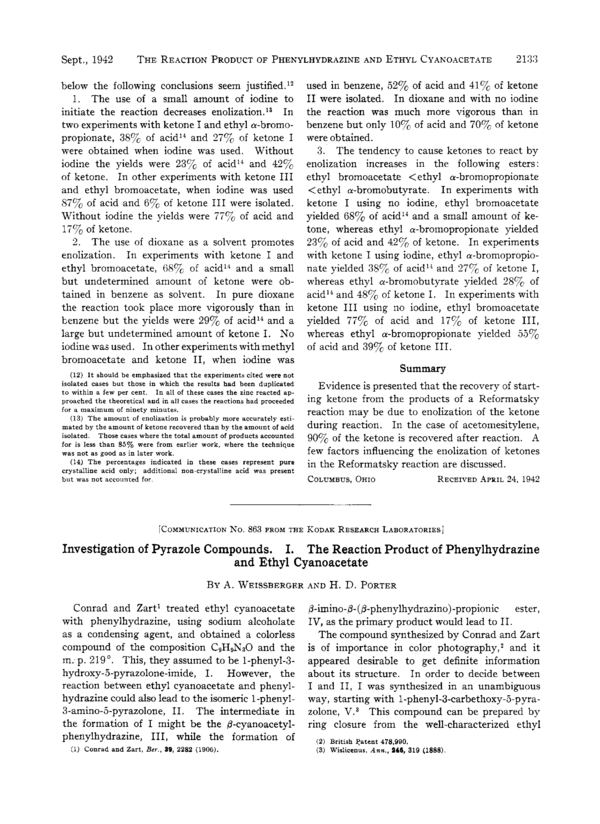Investigation of Pyrazole Compounds. I. The Reaction Product of Phenylhydrazine and Ethyl Cyanoacetate
Investigation of Pyrazole Compounds. I. The Reaction Product of Phenylhydrazine and Ethyl Cyanoacetate
Folder:
Year:
Abstract:
Conrad and Zart' treated ethyl cyanoacetate with phenylhydrazine, using sodium alcoholate as a condensing agent, and obtained a colorless compound of the composition C9H9N30and the m. p. 219". This, they assumed to be l-phenyl-3- hydroxy-5-pyrazolone-imide,I. However, the reaction between ethyl cyanoacetate and phenyl- hydrazine could also lead to the isomeric l-phenyl- 3-amino-5-pyrazolone, 11. The intermediate in the formation of I might be the P-cyanoacetyl- phenylhydrazine, 111, while the formation of P-imino-P-(P-phenylhydrazino)-propionicester,IV, as the primary product would lead to 11.
DOI:
10.1021/ja01261a034
Type of document:
Language:
Sept., 1942
THEREACTION
PRODUCTPHENYLHYDRAZINE
OF
AND ETHYL
CYANOACETATE 2133
below the following conclusions seem justified. l 2
1. The use of a small amount of iodine to
initiate the reaction decreases enolization.13 In
two experiments with ketone I and ethyl a-brornopropionate, 3S% of acidI4 and 2iY0 of ketone I
were obtained when iodine was used. Without
iodine the yields were 23% of acid14 and 42%
of ketone. In other experiments with ketone I11
and ethyl bromoacetate, when iodine was used
S7% of acid and 6% of ketone I11 were isolated.
Without iodine the yields were 77y0of acid and
liYc of ketone.
2 . The use of dioxane as a solvent promotes
enolization. In experiments with ketone I and
ethyl bromoacetate, 68% of acid14 and a small
but undetermined amount of ketone were obtained in benzene as solvent. In pure dioxane
the reaction took place more vigorously than in
benzene but the yields were 29y0 of acidI4 and a
large but undetermined amount of ketone I. No
iodine was used. I n other experiments with methyl
bromoacetate and ketone 11, when iodine was
(12) I t should be emphasized that the experiments cited were not
isolated cases but those in which the results had been duplicated
t o within a few per cent. In all of these cases the zinc reacted approached the theoretical and in all cases the reactions had proceeded
for a maximum of ninety minutes.
(13) The amount of enolization is probably more accurately estimated by the amount of ketone recovered than by the amount of acid
isolated. Those cases where the total amount of products accounted
for is less than 85% were from earlier work, where the technique
was not as good as in later work.
(14) T h e percentages indicated in these cases represent pure
crystalline acid only; additional non-crystalline acid was present
but was not accounted for.
[COMMUNICATION NO.
863
FROM THE
used in benzene, !%!yo acid and 4 7 of ketone
of
1,
I1 were isolated. In dioxane and with no iodine
the reaction was much more vigorous than in
benzene but only 10% of acid and 70% of ketone
were obtained.
3. The tendency to cause ketones to react by
enolization increases in the following esters :
ethyl bromoacetate
Coments go here:
- Log in to post comments

